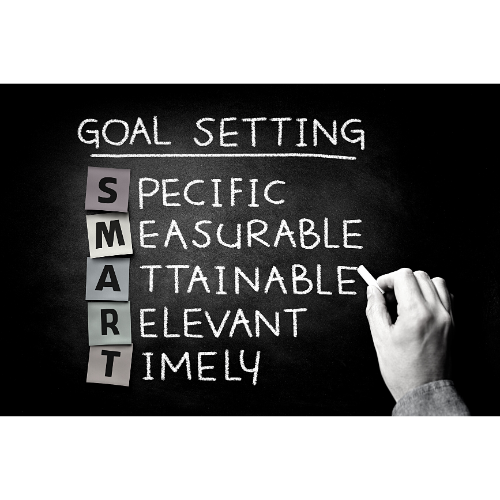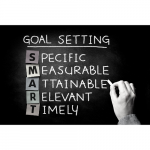Goal setting is a crucial part of any business strategy, especially in the realm of product management. One popular technique for setting effective, clear, and achievable goals is the SMART framework. It encourages precise and realistic goal setting, thereby increasing the chances of success.
Contents
This series of posts focuses on the crucial concepts of product management, including product strategy, roadmap creation, market analysis, and UX design. The goal is to give a comprehensive overview of the key principles and practices all product managers should understand.
🔍 If you want to read the concise version of this post then just read the text written in bold.
What are SMART Goals?
SMART is an acronym, and each letter stands for a characteristic that should be embodied in a goal:
S: Specific
- Definition: specific means that the goal should be clear and precise. It should provide a well-defined path rather than a vague direction. Having a specific goal gives you clarity on what exactly needs to be achieved.
- Key Questions: what exactly are we trying to accomplish? who needs to be involved? where is it going to happen? why is it important?
- Examples: Poor Goal: “Improve product quality.”; Good Goal: “Reduce the number of product defects by 15% in the next 6 months.”
M: Measurable
- Definition: a measurable goal is one that can be quantified and tracked. This makes it easier to evaluate progress and determine when the goal has been achieved.
- Key Questions: How much? How many? How will I know when it is accomplished?
- Example: Poor Goal: “Increase customer satisfaction.”; Good Goal: “Increase customer satisfaction ratings from 75% to 90% over the next year.”
A: Achievable
- Definition: the goal should be realistic and attainable given your resources, constraints, and existing commitments. An achievable goal is one that can be reached with a reasonable amount of effort and application.
- Key Questions: Can we get it done in the proposed timeframe? Do I understand the limitations and constraints? Do we have the resources (people, technology, budget) to achieve the goal?
- Example: Poor Goal: “Add 20 new features to the product in the next week.”; Good Goal: “Add 4 new features to the product in the next two months.”
R: Relevant
- Definition: a relevant goal is one that aligns with your broader business objectives and values. It’s something that’s worth achieving and will have a positive impact on your overall strategy.
- Key Questions: Does this seem worthwhile? Is it the right time? Does it match our other efforts and needs?
- Example: Poor Goal: “Create a new product line of winter clothing.” (for a company specializing in beachwear); Good Goal: “Expand our line of beach accessories with three new items this summer season.”
T: Time-bound
- Definition: goals should have a clear start and end date. Having a deadline helps to prevent everyday tasks from taking precedence and encourages focus. It creates a sense of urgency and prompts action.
- Key Questions: When does the goal need to be met? What is the deadline?
- Example: Poor Goal: “Increase sales.”; Good Goal: “Increase sales by 15% over the next fiscal quarter.”
Practical Examples
Example 1: a vague goal might be “We want to increase user engagement.” A SMART goal version could be, “We aim to increase active user engagement by 25% over the next quarter, measured by weekly active users and average session length.”
Example 2: instead of saying, “We want more customers,” a SMART goal would be, “Increase our customer base by 15% by the end of the next fiscal year, through targeted marketing campaigns and leveraging customer referrals.”
SMART step by step
Step 1: define what you want to achieve. Begin by clearly identifying what you want to accomplish. Be explicit about the end result. It’s essential that the goal is meaningful and important to keep you motivated.
Step 2: make the goal specific. Take the goal you defined in Step 1 and refine it to make it more specific. Define what the goal looks like, who is involved, where it will happen, and why it is important.
Step 3: make it measurable. How will you know when you’ve achieved your goal? Specify what evidence will demonstrate that the goal has been reached. This might be a numerical target, a completed task, or a visible change.
Step 4: check the goal is achievable. Review your goal to make sure it’s attainable considering your current resources, skills, and constraints. If it isn’t achievable as currently defined, consider breaking it down into smaller, more manageable goals.
Step 5: ensure the goal is relevant. Examine how this goal aligns with your broader business objectives or personal goals. If it doesn’t align, you might need to reevaluate its value and priority.
Step 6: set a deadline. Determine a timeline or deadline for your goal. A clear endpoint creates urgency, helps motivate action, and allows you to measure progress.
Step 7: create an action plan. Based on the goal, create a step-by-step plan outlining how you will achieve it. This plan will serve as your roadmap, guiding you towards achieving your goal.
Step 8: review and adjust. Regularly review your progress towards the goal. If you’re falling behind, you might need to adjust your plan or timeline. Remember, the goal is to make progress, not to stick rigidly to a plan if it’s not working.
Step 9: celebrate success. Once you’ve achieved your goal, take time to reflect on your success. This can be a powerful motivator for setting and achieving future goals.
Remember, while SMART is a great framework for goal-setting, goals themselves are dynamic. Don’t hesitate to revise and adapt them as circumstances change. Goals should guide and inspire action, not create unnecessary pressure or stress.
Recommended readings
If you’re still keen to know more about SMART goals, here are a few interesting articles.
“S.M.A.R.T. Goals: Definition and Examples,” by Indeed
“Goal Setting: A Scientific Guide to Setting and Achieving Goals,” by James Clear
The SMART framework is a powerful tool for setting effective and achievable goals. It ensures that your goals are aligned with your business strategy and provides a clear path to follow. While it isn’t the only method for setting goals, it offers a structured approach that improves clarity, focus, and motivation. Embracing SMART goal setting can help you elevate your product management practices, increasing the chances of your product’s success.

